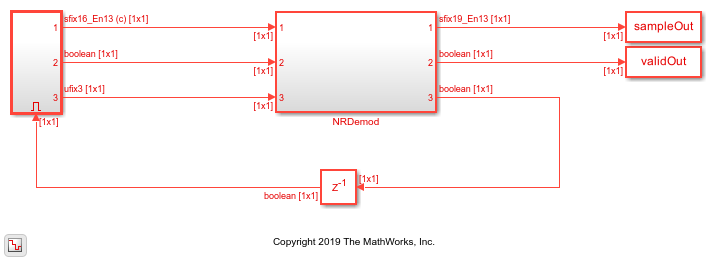NR Symbol Demodulator
Demodulate complex NR data symbols to data bits or LLR values
Libraries:
Wireless HDL Toolbox /
Modulation
Description
The NR Symbol Demodulator block demodulates complex data symbols to data bits or log likelihood ratios (LLR) values based on the modulation types supported by 5G New Radio (NR) standard TS 38.211 [1]. The block provides an architecture suitable for HDL code generation and hardware deployment. You can use this block in the development of an NR receiver.
The block accepts data symbols, along with a valid signal, and outputs demodulated bits or LLR values with valid and ready signals. The number of demodulated bits or LLR values for a given symbol depends on the modulation type, as shown in this table.
| Modulation Type | Number of Bits per Symbol (NBPS) |
|---|---|
| BPSK | 1 |
| QPSK | 2 |
| 16-QAM | 4 |
| 64-QAM | 6 |
| 256-QAM | 8 |
| pi/2-BPSK | 1 |
The ready output port indicates when the block can accept an input data sample. You can use ready output port to control the upstream data coming to the block.
Examples
Ports
Input
Output
Parameters
Algorithms
References
[1] 3GPP TS 38.211. "NR; Physical channels and modulation." 3rd Generation Partnership Project; Technical Specification Group Radio Access Network. URL: https://www.3gpp.org.
[2] F. Tosato and P. Bisaglia. "Simplified soft-output de-mapper for binary interleaved coded OFDM with application to HIPERLAN/2." ICC 2002, Vol. 2, pp. 664–668.
Extended Capabilities
Version History
Introduced in R2019b



